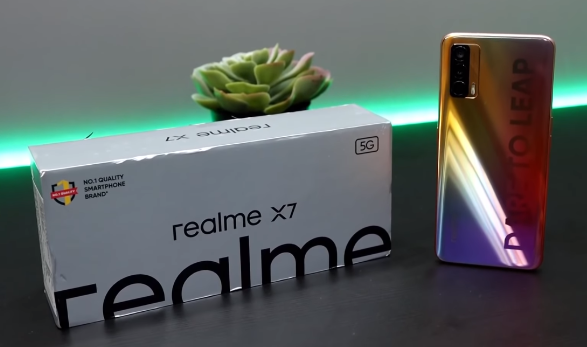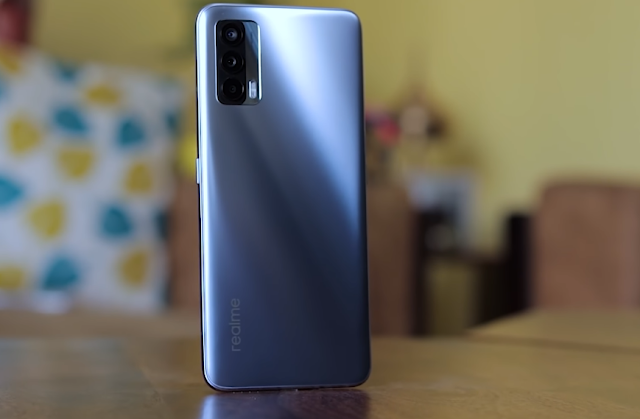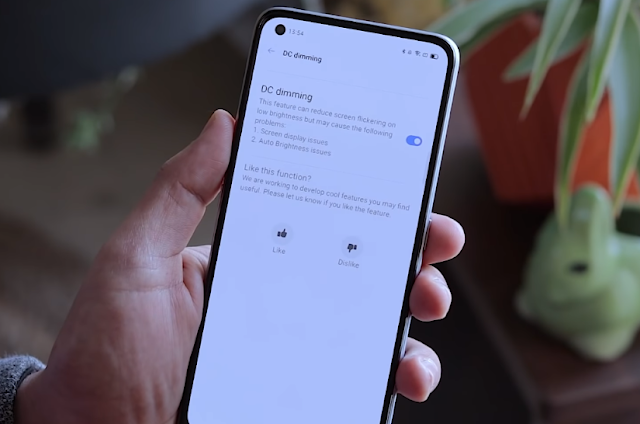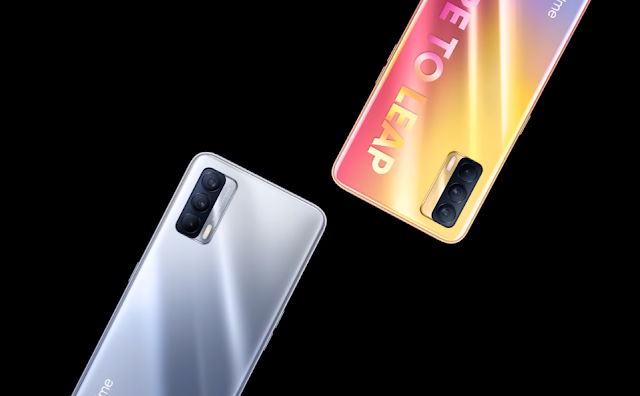Realme X7 brings the support of 5G with some good specs.
Realme has been one of the most popular smartphone manufacturers in the mid-range and budget segment. Last year, the Realme 7 series was launched that included the Realme 7 and the Realme 7 Pro. The Realme 7 Pro was quite a good smartphone as it came with an AMOLED display, a good set of cameras, a Snapdragon 720G chipset, and the most highlighting feature was the 65W fast charging.
Now Realme has brought in a new series called the X7 series in the mid-range segment that includes the Realme X7 and the Realme X7 Pro. The Realme X7 feels like almost a clone of the Realme 7 Pro but there are some differences and the biggest talking point about the Realme X7 is the newer Mediatek Dimensity 800U chipset.
Well, this is the first smartphone to be powered by this chipset as brings with it support for 5G making it the cheapest 5G smartphone till now. Not only 5G, but it also has an AMOLED display, 50W fast charging, and much more. How is it different from the Realme 7 Pro and see whether is it worth buying?
Realme X7 Design:
In terms of design, like the
Realme 7 Pro (Review), the Realme X7 comes with a polycarbonate back which makes it slightly a disappointment compared to the Xiaomi Mi 10i which has a glass back. The back of the Realme X7 has a rectangular setup that houses three cameras instead of the four on the Realme 7 Pro.
The Realme X7 is available in two colors that include Nebula and Space Silver. The Nebula color option is a bit polarizing as it provides a mixture of peach, pink, blue, yellow, gold, and purple when you look at it. The back has a shining pattern when light is struck at different angles.
There is a huge " Dare To Leap" logo at the back which may be eye-catching to some or an extra but still, this is what you are getting at the back. On the other hand, the Space Silver looks cleaner and this too has a slight gradient pattern. The back is glossy and does catch a lot of fingerprints.
There is a slight difference between thickness on the two color options where the Nebula variant is 8.3mm whereas the Space Silver is 8.1mm in thickness. The Nebula weighs 179 grams and the Space Silver at 176 grams. To the sides, the whole frame is made up of plastic also.
On the sides, on the right side, we have a power button and to the left, there are the volume buttons. At the bottom, there is a USB Type-C port, a primary microphone, a loudspeaker grill, and a dual SIM card slot. However, you miss out on a 3.5mm headphone jack and support for a microSD card slot for storage expansion both of which the Realme 7 Pro had.
The top of the smartphone only houses a secondary noise-canceling microphone. On the front, there is a single punch-hole display with minimum bezels to the sides. There is no IP rating, but Realme has provided some coating at the back which makes it somewhat splash resistant to water.
Overall, the design looks good but some major emissions like a 3.5mm headphone jack, support for microSD card, and polycarbonate back feels like Realme has done these to keep costs low of the smartphone.
Realme X7 Display:
In terms of display, the Realme X7 sports a 6.4 inches Full HD+ (1080 x 1920 pixels) Super AMOLED display with a screen to body ratio of 19.5:9. The screen contrast is good and since the display is AMOLED, the color reproduction is good and the viewing angles are great.
However, this display has the standard 60Hz refresh rate and no 90 or 120Hz refresh rate as found on the
Xiaomi Mi 10i (Review). This will not create much of a difference as for getting a higher refresh rate display on an AMOLED, you have to look at the OnePlus Nord.
The display is protected by Corning Gorilla Glass 5 and there are almost no bezels to the sides except the bottom which has a larger chin. The front-facing camera sits in the top left corner. Coming to the display, the brightness levels are much better compared to IPS LCD displays. Under direct sunlight, visibility is good and under dark conditions, there will not be any problem.
Realme has added some features like DC dimming since this is an AMOLED display, smooth scrolling, there is also an Always-On display for notifications, and the touch sampling rate is capped at 180Hz which makes scrolling much smoother. The display has Widevine L1 so streaming HD contents from Netflix, Prime, etc will not be an issue.
There is also support for HDR10+ and the Realme X7 has an optical in-display fingerprint scanner under the display which is quite accurate and fast. There is a Face Unlock that works well most of the time. Overall, the display feels good as it is AMOLED which makes it much better for media consumption.
Realme X7 Performance:
The Realme X7 is the first smartphone to have the newer Mediatek Dimensity 800U chipset which is a powerful mid-ranger chipset and the biggest thing is this chipset brings along the support for 5G. The Mediatek Dimensity chipset is an octa-core chipset having 2x2.4 GHz Cortex A76 cores for higher performance and another 6x2.0 GHz Cortex A55 cores for power efficiency.
All tasks like scrolling through webpages, streaming social media, multi-tasking felt much easier on the smartphone. All heavy games like Call of Duty, Gensian Impact ran fine at the highest graphics settings. Though there is no high refresh rate, the 180Hz touch sampling rate ensures smooth gameplay.
This chipset is built on an efficient 7nm process and has the Mali-G57 MC3 GPU. There were some frame drops noticed at the highest graphics settings and after prolonged gaming for 3-4 hours, the back of the smartphone does get slightly warmer. However, it is better than the gameplay on the Realme 7 Pro which has a Snapdragon 720G chipset.
In terms of benchmarks, the Realme X7 scored 597 and 1789 in single and multi-core tests on Geekbench 5.1 and around 324998 on Antutu v8 respectively. The scores almost on par with the Snapdragon 750G found on the Xiaomi Mi 10i and the
Moto G 5G (Review). The Xiaomi Mi 10i scored 659 and 2011 in single-core and multi-core tests and 334509 on Antutu v8 respectively.
There are only two storage variants that include 6/8GB LPDDR4X RAM and 128GB UFS 2.1 storage. There is no dedicated microSD card for storage expansion so you are only limited to the internal storage. The biggest talking point about this chipset is the support for 5G. So, the overall performance feels well and makes it great for multi-tasking.
Realme X7 Software:
Like all Realme smartphones, the Realme X7 runs on RealmeUI 1.0 based on Android 10. Realme has promised for the newer RealmeUI 2.0 which is built on Android 11 very soon. RealmeUI has been improved in each update as it provides a software experience almost close to Stock Android.
You get some Stock apps like a dialler, messaging, and calendar app. When you swipe left from your home screen, there is a Google Feed and since it has Android 10, there are the navigation gestures, a system-wide dark mode, and Digital Wellbeing.
There is some amount of bloatware present as there are some third-party applications like Facebook, Amazon, Flipkart, SoLoop video editor, etc. that do eat up memory and can be uninstalled easily. But there are a lot of notifications and some ads noticed in the RealmeUI make it slightly disappointing.
Realme has put in some hardware-specific features called "experimental features" such as smooth scrolling, DC dimming that results in color shift most of the time and it also reduces flickering plus you are getting Super Nightime Standby that saves power by reducing mobile network usage. Overall, the software experience feels good on the smartphone.
Realme X7 Camera:
In terms of cameras, the Realme X7 is slightly different from the Realme 7 Pro. The Realme X7 has a triple camera setup that includes a 64MP f/1.8 main camera, an 8MP f/2.2 ultrawide camera, and a 2MP f/2.4 macro camera while the Realme 7 Pro gets an additional 2MP depth camera.
The Realme 7 Pro had a 64MP Sony IMX682 sensor for the main camera while the Realme X7 gets the older Samsung ISOCELL GW1 sensor for the 64MP camera found on the Realme 6 and the
Realme 6 Pro (Review) launched last year. The images come out with good details but there are some scenes of overexposure and the colors do not look balanced.
However, the dynamic range is good and the noise is well maintained. But when you zoom into the image, you can clearly see a lot of noise, and the colors do look slightly washed out. The 64MP mode results out in well-detailed images which do crop in some details to reduce noise and dynamic range.
After zoom
At night, the images have a good dynamic range and the colors look well balanced but there is a large amount of noise and the exposure in the images is not so well maintained. Turning on the Night Mode does improve the exposure at night thus reducing noise also. But anyhow, this 64MP camera does not do well as the 64MP camera on the Realme 7 Pro or the 108MP camera on the Xiaomi Mi 10i.
With Night Mode
The 8MP f/2.2 ultrawide camera has an average dynamic range and the colors are not as good as on the main camera as there is a lot of noise present and the colors look washed out slightly around the edges. When you zoom into the image, the objects look distorted and the white balance is not so good but still, it gets the job done.
The images from the ultrawide camera have above average dynamic range and here also the colors look washed out. There is a Night Mode which does brighten up the environment by making it yellow in the image but still, there is a lot of noise and these images are just used if you want that wider field of view.
There is a 2MP macro camera that takes average close-up images as close as 4cm with average dynamic range and the colors look washed out. There is no autofocus so locking focus on a particular subject is slightly cumbersome as there are some focus issues. Instead, you can use the main camera by going close to the subject and cropping in to get better macro shots.
In terms of portraits, the images have a good dynamic range and the edge detection is also perfectly implemented. The skin tones look natural on a human subject but when you zoom in, you can clearly see a lot of noise and the details look slightly softer. The background blur provided by the camera is good and you can further adjust it or apply different filters.
On the front, there is a 16MP f/2.5 camera which seems like a downgrade compared to the 32MP camera on the Realme 7 Pro. The details come out good and the colors look punchier also. There is some skin smoothening enabled by default which can be turned off to get better results.
During the night, the selfies come out with an average dynamic range but there is a lot of noise noticed in the background. However, the portraits from the front camera come out with better details and edge detection but the background blur is not so good as the subjects can be clearly noticed as subject separation is not so good.
In terms of videos, the Realme X7 supports 4K video recording at 30fps. The videos have a good dynamic range and the colors look accurate but sometimes there is overexposure noticed. Since there is no OIS, there is a lot of noise in the videos and shakiness noticed in the videos.
However, switching to 1080p resolution at 30 or 60fps results in better videos as EIS kicks in thus improving dynamic range and maintains the color temperature with lesser noise and better stabilization. There is also support for slow-mo video recording at 720p at 240fps.
The videos from the ultrawide camera come out with average details and the colors look well balanced but there is over-sharpening noticed. The Super Stable helps achieves better video stabilization but when it comes to night, there is a lot of noise noticed and the natural look of the subjects in the videos is totally impaired.
The videos from the main camera with the Night Mode turned on the result in better dynamic range and accurate colors in the videos. But there is a lot of noise and some scenes of overexposure. The videos from the front camera come out with a decent dynamic range and details.
You can also take portrait video both from the front and the rear camera but background blur needs an improvement on the front camera. The edge detection works well though. The Realme 7 Pro does a better job compared to the Realme X7.
Overall, the cameras feel impressive on the Realme X7 and will get the job done. For better camera results, the Realme 7 Pro is the better one to go as it has better cameras or the Xiaomi Mi 10i that has a 108MP camera.
Realme X7 Battery Life:
The Realme X7 has a 4310mAh battery which can last easily for one to two days with normal usage. Since the Mediatek Dimensity 800U chipset is built on a 7nm process, the battery efficiency is better also. With normal usage, the smartphone can last up to two days on a single charge. With heavy usage, the smartphone can easily last for one single day and with some charge left.
The standard screen on time was around 5-6 hours and Realme has provided different power saving modes to conserve battery. The battery optimizations are also improved with each update of the RealmeUI and since this is an AMOLED display it consumes lesser power compared to other IPS LCD displays with a higher refresh rate.
In terms of charging, the Realme X7 can charge the first 50 percent in 15 minutes and a full charge can take around 45 minutes with the supplied 65W fast charger. This is slower compared to the Realme 7 Pro that supports 65W fast charging which can charge from 0 to 100 percent in under 30 minutes.
The charging speed for the Realme X7 is limited to 50W but Realme has supplied a 65W fast charger inside the box. The battery life feels good as it has an AMOLED display and is built on a 7nm process and the fast charging is amazing.
Realme X7 Audio Quality:
The Realme X7 houses only a single speaker at the bottom which is adequately loud but at higher loudness levels, the sound is slightly muffled and you do miss the stereo speakers which were present on the Realme 7 Pro.
There is Dolby Atmos for enhanced sound effect and support for Hi-Res audio output but the only issue is like when you are playing games, the speaker tends to get covered and it blocks the sound output as a result.
There is no 3.5mm headphone jack, so you are left with a pair of wireless earphones which is sort of disappointing as the Realme 7 Pro had a 3.5mm headphone jack. Realme does provide a USB Type-C to 3.5mm connector inside the box. Still, the audio quality is better compared to many smartphones but with stereo speakers, it could have been much better.
Verdict:
The Realme X7 feels like a good complete smartphone and the most interesting fact is that it supports 5G making it the cheapest 5G smartphone to date. It has an AMOLED display, a powerful Mediatek chipset, and good battery life with fast charging. The RealmeUI provides a good software experience though.
But there are some flaws like the omission of a microSD card slot for storage expansion, 3.5mm headphone jack, and lack of stereo speakers which the similarly priced Realme 7 Pro has. The cameras do a good job but when compared to other cameras on smartphones like the Realme 7 Pro and the Xiaomi Mi 10i, do fall short.
In terms of build and design, Realme has used a plastic back to keep costs lower also. In terms of gaming and performance, the chipset handles everything well but if you want hard-core gaming, then the Snapdragon 750G powered Xiaomi Mi 10i or the Moto G 5G would do a slightly better job.
To sum up, the Realme X7 does everything fine and good though there are some flaws. If you overcome these flaws, then what you are getting is a good 5G mid-range smartphone with all the necessities which makes it worth buying.

























0 Comments
Please do not enter any spam link in the comment box